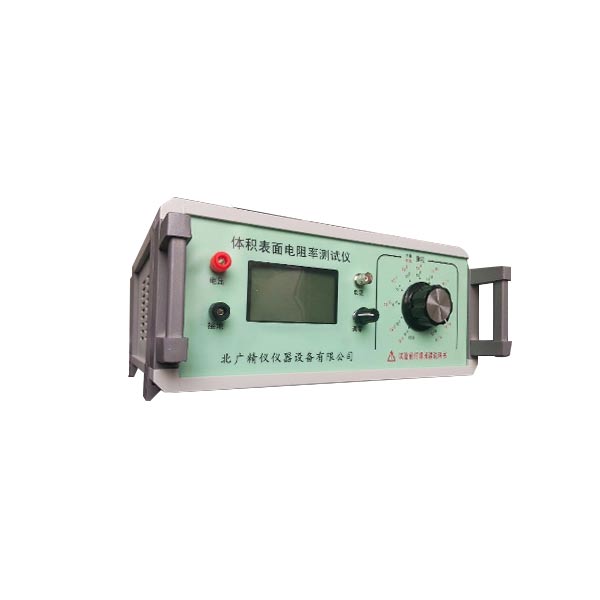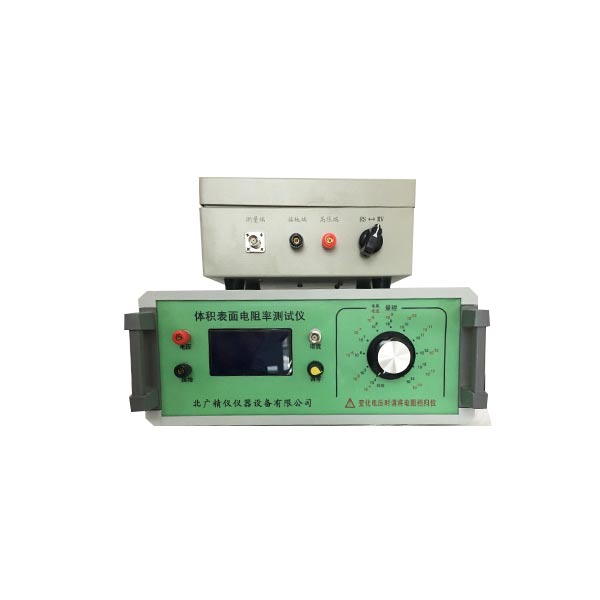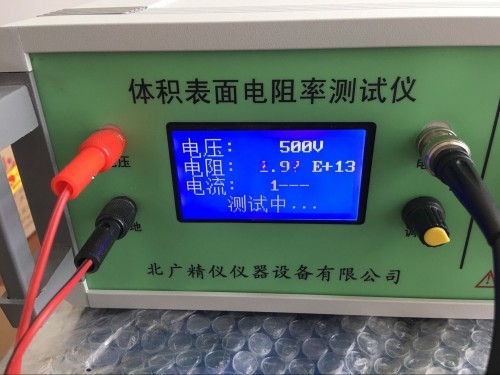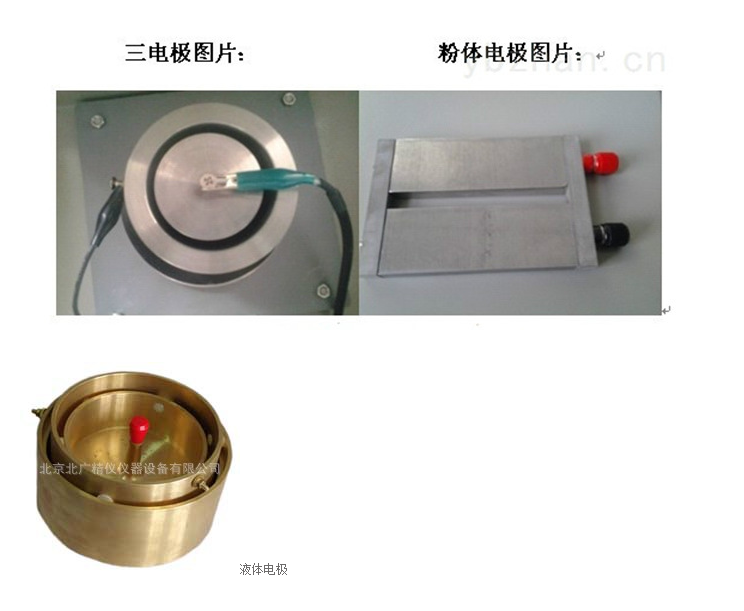
塑料體積電阻率測試儀 什么是體積電阻率?
體積電阻率,是材料每單位體積對電流的阻抗,用來表征材料的電性質。通常體積電阻率越高,材料用做電絕緣部件的效能就越高。通常所說的電阻率即為體積電阻率。
,式中,h是試樣的厚度(即兩極之間的距離);S是電極的面積,ρv的單位是Ω?m(歐姆?米)。
材料的導電性是由于物質內部存在傳遞電流的自由電荷,這些自由電荷通常稱為載流子,他們可以是電子、空穴、也可以是正負離子。在弱電場作用下,材料的載流子發生遷移引起導電。材料的導電性能通常用與尺寸無關的電阻率或電導率表示,體積電阻率是材料導電性的一種表示方式。
簡言之,在絕緣材料里面的直流電場強度與穩態電流密度之商,即單位體積內的體積電阻.
塑料體積電阻率測試儀 主要標準:
GB/T 1410-2006《 固體絕緣材料體積電阻率和表面電阻率試驗方法》
ASTM D257-99 《絕緣材料的直流電阻或電導試驗方法》
GB/T 2439-2001《硫化橡膠或熱塑性橡膠 導電性能和耗散性能電阻率的測定》
GB/T 10581-2006《絕緣材料在高溫下電阻和電阻率的試驗方法》
GB/T 1692-2008《硫化橡膠絕緣電阻率的測定》
GB/T 12703.4-2010《紡織品 靜電性能的評定 第4部分:電阻率》
GB/T 10064-2006《測定固體絕緣材料絕緣電阻的試驗方法》
材料說明
A、通常,絕緣材料用于電氣系統的各部件相互絕緣和對地絕緣,固體絕緣材料還起機械支撐作用.一般希望材料有盡可能高的絕緣電阻,并具有合適的機械、化學和耐熱性能.
B、體積電阻班組可作為選擇絕緣材料的一個參數,電阻率隨溫度和濕度的京戲化而顯著變化.體積電阻率的測量常常用來檢查絕緣材料是否均勻,或都用來檢測那些能影響材料質量而又不能作其他方法檢測到的導電雜質.
C、當直流電壓加到與試樣接觸的兩電極間時,通過試樣的電流會指數式地衰減到一個穩定值.電流隨時間的減小可能是由于電介質極化和可動離子位移到電極所致.對于體積電阻小于10的10Ω.m
的材料,其穩定狀態通常在1min內達到.因此,要經過這個電化時間后測定電阻.對于電阻率較高的材料,電流減小的過程可能會持續幾分鐘、幾小時、幾天,因此需要用較長的電化時間.如果需要的話,可用體積電阻率與關系來描述材料的特性.
D、由于體積電阻總是要被或多或少地包括到表面電阻的測試中去,因些近似地測量表面電阻,測得的表面電阻值主要反映被測試樣表面污染的程度.所以,表面電阻率不是表面材料本身特性的參數,而是一個有關材料表面污染特性的參數.
當表面電阻較高時,它常隨時間以不規則的方式變化.測量表面電阻通常都規定11min的電化時間.
符合標準及適用范圍:

完全符合國家標準GB1410-2006固體電工絕緣材料絕緣電阻、體積電阻系數和表面電阻試驗方法,ASTM D257絕緣材料的直流電阻或電導試驗方法 等標準要求。
本儀器配不同的測量電極(夾具)可以測量不同材料(固體、粉體或液體)的體積電阻率和表面電阻率或電導率。適用于橡膠、塑料、薄膜、及粉體、液體、及固體和膏體形狀的各種絕緣材料體積和表面電阻值的測定。本儀器除能測電阻外,還能直接測量微弱電流。
技術指標
1.電阻測量范圍:0.01?10 4Ω ~1?10 18Ω。
2.電流測量范圍為: 2?10-4A~1?10-16A
3.雙表頭顯示: 3.1/2位LED顯示
4.內置測試電壓:10V、50V、100V、250、500、1000V
5.準確度:準確度優于下表
量程有效顯示范圍20~30℃RH<80%
104 0.01~19.99 5%
105 0.01~19.99 5%
106 0.01~19.99 5%
107 0.01~19.99 5%
108 0.01~19.99 5%
109 0.01~19.99 5%

1010 0.01~19.99 5% 2字
1011 0.01~19.99 5% 2字
1012 0.01~19.99 5% 5字
1013 0.01~19.99 10% 5字
1014 0.01~19.99 10% 5字
1014以上0.01~19.99 10-15% 5字
超出有效顯示范圍時誤差有可能增加,測試電流準確度與電阻相同,測試電壓準確度為10%
6使用環境:溫度:0℃~40℃,相對濕度<80%
7機內測試電壓: 10/50/100/250/500/1000V任意切換
8.供電形式: AC 220V,50HZ,功耗約5W
9.儀器尺寸: 285mm?245mm?120 mm
10.質量:約2.5KG
11 測試電壓有六種選擇之多DC10V、50V、100V、250V、500V、1000V;
12 使用操作簡便,在任何電阻量程和測試電壓下均直接讀顯示數字結果,
免去要乘以一個系數的麻煩,使測量超高電阻就如用萬用表測量普通電阻樣簡便。
What is volume resistivity?
Volume resistivity is the impedance of a material to current per unit volume, used to characterize the electrical properties of the material. The higher the volume resistivity, the more effective the material is as an electrical insulation component. The resistivity commonly referred to is the volume resistivity.
In the formula, h is the thickness of the sample (i.e. the distance between the two poles); S is the area of the electrode, and the unit ofρv isΩ?m (ohm meters).
The conductivity of materials is due to the presence of free charges inside the material that transfer current, which are commonly referred to as charge carriers. They can be electrons, holes, or positive and negative ions. Under the action of a weak electric field, the migration of charge carriers in the material causes conductivity. The conductivity of materials is usually represented by resistivity or conductivity that is independent of size, and volume resistivity is a way of expressing the conductivity of materials.
In short, the quotient of the DC electric field strength and steady-state current density in insulating materials is the volume resistance per unit volume
Main standards:
GB/T 1410-2006 "Test Method for Volume and Surface resistivity of Solid Insulation Materials"
ASTM D257-99 "Test Method for DC Resistance or Conductivity of Insulation Materials"
GB/T 2439-2001 "Determination of Electrical Conductivity and Dissipation Properties of Vulcanized Rubber or Thermoplastic Rubber"
GB/T 10581-2006 "Test method for resistance and resistivity of insulating materials at high temperatures"
GB/T 1692-2008 "Determination of Insulation Resistance of Vulcanized Rubber"
GB/T 12703.4-2010 "Evaluation of electrostatic properties of textiles - Part 4: Electrical resistivity"
GB/T 10064-2006 "Test Method for Determining Insulation Resistance of Solid Insulation Materials"
Material Description
A. Usually, insulation materials are used for mutual insulation and ground insulation of various components in electrical systems, and solid insulation materials also serve as mechanical support Generally, it is desirable for materials to have the highest possible insulation resistance and appropriate mechanical, chemical, and heat resistance properties
B. The volume resistance group can be used as a parameter for selecting insulation materials, and the resistivity varies significantly with temperature and humidity The measurement of volume resistivity is often used to check whether the insulation material is uniform, or to detect conductive impurities that can affect material quality but cannot be detected by other methods
C. When a direct current voltage is applied between the two electrodes in contact with the sample, the current passing through the sample will exponentially decay to a stable value The decrease in current over time may be due to dielectric polarization and the displacement of movable ions to the electrode For 10Ω?m with a volume resistance less than 10
The material typically reaches a stable state within 1 minute Therefore, the resistance should be measured after this electrification time For materials with high resistivity, the process of current reduction may last for several minutes, hours, or days, thus requiring a longer electrochemical time If necessary, volume resistivity and its relationship can be used to describe the properties of materials
D. Due to the fact that volume resistance is always included to a greater or lesser extent in surface resistance testing, surface resistance is approximately measured, and the measured surface resistance value mainly reflects the degree of surface contamination of the tested sample So, surface resistivity is not a parameter of the surface material itself, but a parameter related to the surface pollution characteristics of the material
When the surface resistance is high, it often changes irregularly over time The measurement of surface resistance usually requires an electrochemical time of 11 minutes
Compliance with standards and scope of application:
Fully comply with the national standard GB1410-2006 Test Methods for Insulation Resistance, Volume Coefficient of Resistance, and Surface Resistance of Solid Electrical Insulation Materials, as well as ASTM D257 Test Methods for DC Resistance or Conductivity of Insulation Materials.
This instrument, equipped with different measuring electrodes (fixtures), can measure the volume resistivity, surface resistivity, or conductivity of different materials (solids, powders, or liquids). Suitable for measuring the volume and surface resistance values of various insulation materials in the shapes of rubber, plastic, film, powder, liquid, solid, and paste. This instrument can not only measure resistance, but also directly measure weak currents.
Technical indicators
1. Resistance measurement range: 0.01?10 4Ω~1?10 18Ω.
2. The range of current measurement is: 2?10-4A~1?10-16A
3. Dual header display: 3.1/2 LED display
4. Built in test voltage: 10V, 50V, 100V, 250, 500, 1000V
5. Accuracy: Accuracy is better than the following table
Effective display range of range: 20-30℃RH<80%
104 0.01~19.99 5%
105 0.01~19.99 5%
106 0.01~19.99 5%
107 0.01~19.99 5%

108 0.01~19.99 5%
109 0.01~19.99 5%
1010 0.01~19.99 5% 2 words
1011 0.01~19.99 5% 2 words
1012 0.01~19.99 5% 5 words
1013 0.01~19.99 10% 5 words
1014 0.01~19.99 10% 5 words
Above 1014, 0.01~19.99, 10-15% 5 words
When the effective display range is exceeded, the error may increase. The accuracy of the test current is the same as that of the resistance, and the accuracy of the test voltage is 10%
6. Operating environment: Temperature: 0℃~40℃, relative humidity<80%
7. Internal testing voltage: 10/50/100/250/500/1000V can be switched freely
8. Power supply form: AC 220V,50HZ,Power consumption is about 5W
9. Instrument size: 285mm?245mm?120mm
10. Quality: Approximately 2.5KG
There are six options for testing voltage: DC10V, 50V, 100V, 250V, 500V, and 1000V;
Easy to use and operate, it can directly read and display digital results at any resistance range and test voltage,
Eliminating the hassle of multiplying by a coefficient, making measuring ultra-high resistance as easy as measuring ordinary resistance with a multimeter.
業務咨詢:932174181 媒體合作:2279387437 24小時服務熱線:15136468001 盤古機械網 - 全面、科學的機械行業免費發布信息網站 Copyright 2017 PGJXO.COM 豫ICP備12019803號